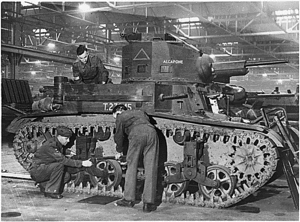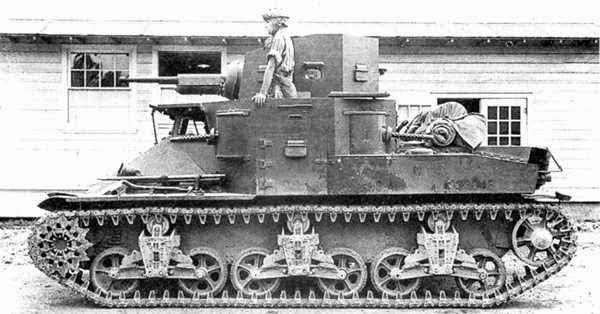Rock Island Arsenal aloitti uuden tankin sunnittelun joka perustuu M2 Light Tankkiin.

Vaunun työnimi T5, joka oli uudistettu malli ja suurempi 350 hv R - 975 tähtimoottori, alettiin kesäkuussa 1939 käyttää uudelleen nimitystä M2 Medium Tankki.
Kun Rock Island Arsenal oli valmistanut ensimmäiset 18 tankkia ja saanut ne armeijan taholta hyväksynnän, näiden
Hyvin monet vaunujen osia olivat samoja tai saman mallisia joita yleisesti käytettiin myöhemmin valmistetuissa muissa panssarivaunuissa. Näin oli myös pystysuoraan asennettu telapyörien kierrejousitus, kaksois-pyörien telirakenne kiinnitettiin vaunun runkoon ulkopuolelle.
Kumitetut telaketjun holkit ja kumiset telakengät osoittivat tämän kaltaisen telaston rakenteen sopivan ja myös kestävän maantieajossa hyvin.
Alkuperäisessä M2 mallissa oli ilmajäähdytteinen Wright R-975 tähtimoottor joka oli nyt ahdettu antamaan ylimääräinen 50 hv /37 kW.
Moottorin teho oli yhteensä 400 hp tai 300 kW ja nimettiin R-975 C1 tähtimoottoriksi.
Medium M2 tankin kori rakenteen profiili oli korkea, koska jokaisessa kulmassa oli yksi
konekivääri, lisäksi kuljettajan vierelle ikkunalevyyn oli asennettu kaksi konekivääriä. Tornissa, vaunun pää aseena oli 37 mm tykki ja sen vieressä yksi konekivääri.
Lisäksi tornin huipulla oli valmiudet asentaa kaksi ilmatorjunta konekivääriä.
Konekiväärien määrä oli siis yhteensä yhdeksän (9) joka oli yhtä paljon kun yleisesti oli asennettu ensimäisen maailman sodan aikaisiin panssarivaunuihin.
Vaunussa oli kuusi miestä, johtaja, kuljettaja, neljä ampujaa. Tämä oli paljon tankissa
jossa oli 200 kpl 37 mm tykin ammusta ja 12250 kpl konekiväärin 0.30 cal. patruunaa.
Kuten taaksepäin ampuvat konekiväärit, myös luotien ohjauslevyt osoittautuivat pian tarpeettomiksi nykyaikaisessa sodankäynnissä.
Chrysler avasi uuden, Detroit Arsenal Tank Plant, tuotantolaitoksen valmistamaan M2 Medium 1000 vaunua jotka Yhdysvaltain hallitus oli alihankinta sopimuksella tilannut Chrysler yhtiöltä elokuussa 1940. Tehtaan tilaus koski Medium Tank M2A1 mallin tankkeja, joissa oli hieman paksumpi panssarointi ja hieman suurempi tykkitorni kuin
alkuperäisessä Licht M2 panssarivaunussa. Myös tykin mantteli oli vahvempi. Naitä vaunuja ehdittiin valmistaa 94 kpl ennen kuin tuotanto muutettiin M3 vaunuiksi.
Euroopan tapahtumat osoittivat selvästi, että M2 oli ehdottomasti liian vanha ja hallitus muutti sopimusta ennen kuin tuotanto oli kunnolla aloitettu. Uusi sopimus siirrettiin nyt käsittämään 1000 kpl uudempaa M3 Grant mallin panssarivaunuja.
Medium M2 oli jo vanhentunut, kun se otettiin käyttöön. Verrattuna eurooppalaisten nykyaikaisempiin vaunuihin, kuten Ranskan S-35, Saksan Panzer III ja Neuvostoliiton BT- 7, jotka oli suojattu paremmin 37 mm (1,5 tuumaa) tykin osumilta.
M2 Mediumin 37 mm pää-ase vastasi Panzer III, 37 mm tehoa, mutta ei BT-7 / 45 mm ja
Somu a S-35 / 47 mm tykkejä, jotka olivat paljon tehokkaampia aseita.
1941 saksan Panzer-III sai uuden pääaseen, 50 mm L/42 aseen, ja Neuvostoliitto pystyi
laittamaan peliin ylivoimaiset T-34 vaunut joiden pää-ase oli 76 mm tykki ja viisto 52 mm keulan panssari levy. Medium M2 olikin lähinnä hätävarainen toimenpide, kunnes kunnes ehdittiin valmistaa paljon kyvykkäämpiä vaunuja kuten M3 Lee ja M4 Sherman joita saatiin yhdysvaltain ja liittolaisten käyttöön 1942-1943 vuosien aikana.
Vaikka M2 Licht tankkeja valmistettin 18 ja Medium M2 tankkeja 94 puolustusvoimain
materiaali osasto suositteli tammikuu 1942 ettei vaunuja lähetä taistelukentille, vaan ne
käytetään yhdysvaltain armeijan koulutukseen. Yhdysvaltain armeijan harjoituttaa M2 ja Medium M2 vaunuilla varustetun 67. Jalkaväkirykmentin (Medium M2).
Tämän jälkeen muodostettiin ensimmäinen 69. panssaroitu divisioona
69. panssaroitu rykmentti osallistui intensiivisesti sota harjoituksiin 1941 aikana ja M2 suunnitteltu jatko osoittautui käyttökelpoiseksi rooliin panssarivaunujen miehistön
peruskoulutus tehtäviin. 69 rykmentissä koulutetut miehet hajautettiin kouluttamaan
uusia miehiä, yhdysvaltain monille uusille perustetuille panssarivaunu divisioonille
ja kouluttamaan nämä panssarivaunu joukot toimimaan riippumattomina itsenäisinä osastoina, sellaisina kuin niiden rooli haluttiin tulevaisuudessa laajentaa, 1942-1944.
-------------------------------------------------------------------------------
Type: Medium tankM2 Mediumin 37 mm pää-ase vastasi Panzer III, 37 mm tehoa, mutta ei BT-7 / 45 mm ja
Somu a S-35 / 47 mm tykkejä, jotka olivat paljon tehokkaampia aseita.
1941 saksan Panzer-III sai uuden pääaseen, 50 mm L/42 aseen, ja Neuvostoliitto pystyi
laittamaan peliin ylivoimaiset T-34 vaunut joiden pää-ase oli 76 mm tykki ja viisto 52 mm keulan panssari levy. Medium M2 olikin lähinnä hätävarainen toimenpide, kunnes kunnes ehdittiin valmistaa paljon kyvykkäämpiä vaunuja kuten M3 Lee ja M4 Sherman joita saatiin yhdysvaltain ja liittolaisten käyttöön 1942-1943 vuosien aikana.
Vaikka M2 Licht tankkeja valmistettin 18 ja Medium M2 tankkeja 94 puolustusvoimain
materiaali osasto suositteli tammikuu 1942 ettei vaunuja lähetä taistelukentille, vaan ne
käytetään yhdysvaltain armeijan koulutukseen. Yhdysvaltain armeijan harjoituttaa M2 ja Medium M2 vaunuilla varustetun 67. Jalkaväkirykmentin (Medium M2).
Tämän jälkeen muodostettiin ensimmäinen 69. panssaroitu divisioona
69. panssaroitu rykmentti osallistui intensiivisesti sota harjoituksiin 1941 aikana ja M2 suunnitteltu jatko osoittautui käyttökelpoiseksi rooliin panssarivaunujen miehistön
peruskoulutus tehtäviin. 69 rykmentissä koulutetut miehet hajautettiin kouluttamaan
uusia miehiä, yhdysvaltain monille uusille perustetuille panssarivaunu divisioonille
ja kouluttamaan nämä panssarivaunu joukot toimimaan riippumattomina itsenäisinä osastoina, sellaisina kuin niiden rooli haluttiin tulevaisuudessa laajentaa, 1942-1944.
-------------------------------------------------------------------------------
Place of origin: United States
Manufacturer: Rock Island Arsenal
Number built: 18 M2s, 94 M2A1s
Variants: M2, M2A1
Weight: 41,000 lb (18.7 metric tons)
Length: 5.38 m (17.7 ft)
Width: 2.59 m (8 ft 6 in)
Height: 2.82 m (9 ft 3 in)
Crew: 6 (Commander, driver, (4x) gunners)
Armor: M2 6.4–32 mm (0.25–1.26 in) / M2A1 6.4–51 mm (0.25–2.01 in)
Armament: 1× 37 mm Gun M3, 200 rounds
Secondary: 7× (maximum 9) .30-06 Browning M1919 machine guns, 12,250 rounds
Engine: Wright R975 EC2 air-cooled radial gasoline 400/340 hp (298/253 kW)
Suspension: Vertical Volute Spring Suspension (VVSS)
Fuel capacity: 473 liters (125 U.S. gal)
Range: 210 km (130 mi)
Speed: 42 km/h (26 mph)
----------------------------------------------------------------------------------
The Medium Tank M2 was a United States Army tank that was first produced in 1939 by the Rock Island Arsenal, just prior to the commencement of the war in Europe.
Production was 18 M2 tanks, and 94 slightly improved M2A1 tanks, for a total figure of 112. Events in Western Europe and on the Eastern Front rapidly demonstrated that the M2 was obsolete, and it was never used overseas in combat; it was used for training purposes throughout the war.
The M2's unique features included an unusually large number of machine guns, bullet deflector plates, and sloped armor on the hull front (glacis plate). The main armament was a 37 mm (1.5 in) gun, with 32 mm (1.3 in) armor; the M2A1 had a 51 mm (2.0 in) gun mantlet. The features of the M2 series development, both good and bad, provided many lessons for U.S. tank designers that were later applied with great success in the M3 Lee, M4 Sherman and many other armored fighting vehicles.
Rock Island Arsenal started work on a new medium tank, based on the design of the M2 Light Tank. Initially designated the T5, the redesigned model (with a 350 hp R-975 radial engine) was redesignated as the M2 Medium Tank in June, 1939. After the first 18 units had been produced at Rock Island Arsenal and evaluated by the army, the upgraded M2A1 specification was approved with a redesigned turret and a more powerful engine.
The medium tank M2 was a larger development of the M2 Light Tank. Many components were common or used a similar design, including the vertical volute spring suspension which would be used in later tanks as well. Twin-wheeled bogies were mounted externally, and rubber-bushed and rubber-shoed track proved durable on roads.
The initial M2 model was powered by an aircooled Wright R-975 radial engine. For the M2A1, this engine was supercharged to provide an extra 50 hp (37 kW) for a total of 400 horsepower (300 kW), and designated as the R-975 C1 radial engine.

The M2 had a high superstructure, with a sponson-mounted machine gun in each corner. In addition, two more machine guns were fixed in the glacis plate and fired by the driver. Surmounting the superstructure was a small revolving turret armed with a 37 mm Gun M3 and a coaxial machine gun. The 37 mm gun could penetrate 46 mm of face-hardened armor sloped 30° at a range of 500 yards (457 meters), and 40 mm at 1,000 yards (914 meters).
This armament configuration was a hybrid between the sponson-mounted weapons of the Mark VIII Liberty tank of World War I vintage, and the combination of turreted cannon, coaxial machine gun and glacis-mounted machine gun that was almost universal in World War II medium tanks.
(Two additional .30-caliber machine guns could be mounted on pintles on either side of the turret for anti-aircraft use, bringing the total to nine—surely a record for any tank brought into service by any army.) The crew consisted of the tank commander, a driver and four gunners. The vehicle provided internal stowage for 200 rounds of 37 mm ammunition and up to 12,250 rounds of .30-caliber.
Bullet deflector plates were installed over the rear fenders. The idea behind these plates was that the tank could drive over a trench, and the rear sponson machine guns could then fire onto the plates; the bullets would deflect into the trench or the area directly behind the tank. Like the sponson machine guns themselves, the deflector plates turned out to be useless in modern warfare.
Chrysler opened a new tank plant, the Detroit Arsenal Tank Plant, to manufacture the M2, and the US Government contracted in August, 1940 for 1,000 vehicles to be produced. Events in Europe made obvious that the M2 was obsolete, and the government modified the contract before production began.
Instead of M2 medium tanks, the plant would now build 1,000 M3 Grant tanks. Production of the M2 was returned to the Rock Island Arsenal, where 94 M2A1s were eventually built.
The M2A1 had slightly better armor and a slightly larger turret than the original M2, since it had the turret from the M3 Light Tank, with gun mantlet armor 2 inches (51 mm) thick.
The M2 was already obsolete when it entered service. It compared poorly with contemporary European tanks, such as the French S-35, German Panzer III and Soviet BT-7, which were somewhat better protected against 37 mm (1.5 in) hits.
The 37 millimetres (1.5 in) main armament of the M2 was equivalent to the 37 mm (1.5in) the Panzer III, but the 45 mm (1.8 in) BT-7 and 47 mm (1.9 in) S-35 had more powerful guns. By 1941, Germany had upgunned the Panzer III with a 50 mm (2.0 in) L/42 gun, and the Soviets had fielded the vastly superior T-34, with a 76 mm (3.0 in) gun and a sloped 52 mm (2.0 in) glacis plate.
Given this, the M2 was essentially a stopgap measure until more capable tanks like the M3 Lee and M4 Sherman came along in 1942-43. Although 18 M2s and 94 M2A1s were produced, the Ordnance office recommended in January 1942 that they should only be used for training purposes, and they were never sent overseas to combat areas.
The U.S. Army fielded the M2 and M2A1 with the 67th Infantry Regiment (Medium Tanks) and, subsequently, the 1st Armored Division's 69th Armored Regiment during intensive training maneuvers in the United States in 1941, and the M2 design continued to prove useful in a basic training role for tank crewmen.
The trained crewmen from the 69th Armored were scattered to provide cadres to several new armored divisions and independent M4 tank battalions, as U.S. armored forces were rapidly expanded in 1942-44.
















Ei kommentteja:
Lähetä kommentti
Any explosive ammunition or empty cores, you can put in this.